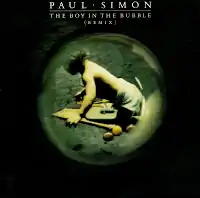The Boy in the Bubble
"The Boy in the Bubble" is a song by the American singer-songwriter Paul Simon. It was the third single from his seventh studio album, Graceland (1986), released on Warner Bros. Records. Written by Simon and Forere Motloheloa (an accordionist from Lesotho), its lyrics explore starvation and terrorism, juxtaposed with wit and optimism.
| "The Boy in the Bubble" | ||||
|---|---|---|---|---|
 | ||||
| Single by Paul Simon | ||||
| from the album Graceland | ||||
| Released | February 1987 | |||
| Genre | ||||
| Length | 4:00 | |||
| Label | Warner Bros. | |||
| Songwriter(s) |
| |||
| Producer(s) | Paul Simon | |||
| Paul Simon singles chronology | ||||
| ||||
The single—released in September 1987—performed well on charts worldwide. In the United States, it was mainly successful on the Album Rock Tracks chart, where it peaked at No. 15. Outside the U.S., "The Boy in the Bubble" was a top 20 hit in the Netherlands, and top 30 in the United Kingdom and Belgium.
Background
The song retains the only lyric Simon managed to compose on his South African trip: "The way the camera follows us in slo-mo, the way we look to us all." The imagery in the video, directed by Jim Blashfield,[1] was inspired by film clips of the John F. Kennedy assassination, as well as Ronald Reagan's attempted assassination.[2] The song's title was presumably inspired by the medical cases of David Vetter and Ted DeVita.[3][4]
He said, "Hope and dread... that's the way I see the world—a balance between the two, but coming down on the side of hope."[2]
"The Boy in the Bubble," like "Graceland," took three to four months to create.[2]
Personnel
- Paul Simon – lead vocals, acoustic guitar, background vocals
- Rob Mounsey – synthesizer
- Adrian Belew – guitar synthesizer
- Forere Motloheloa – accordion
- Bakithi Kumalo – bass
- Vusi Khumalo – drums
- Jacob Childress – percussion
Chart performance
"The Boy in the Bubble" performed on singles charts in several territories worldwide. In the U.S., the song reached a peak of No. 86 on the Billboard Hot 100 on March 21, 1987; it spent four weeks on the chart as a whole.[5] It performed better on the magazine's Album Rock Tracks chart, where it placed at No. 15 on March 28, 1987, where it spent nine weeks total.[6]
In the United Kingdom, the song premiered on the UK Singles Chart on November 30, 1986 at number 81,[7] and rose over the following weeks to a peak of No. 26 on January 11, 1987.[8] On the Dutch Nationale Top 100, it reached a peak of No. 16.[9] On Belgium's Ultratop 50, it hit No. 28,[10] and in New Zealand, it peaked at No. 43.[11]
Charts
| Chart (1987) | Peak position |
|---|---|
| Australia (Kent Music Report)[12] | 46 |
| Belgium (Ultratop 50 Flanders)[10] | 28 |
| Netherlands (Single Top 100)[9] | 16 |
| New Zealand (Recorded Music NZ)[11] | 33 |
| UK Singles (OCC)[8] | 26 |
| US Billboard Hot 100[5] | 86 |
| US Album Rock Tracks (Billboard)[6] | 15 |
Notes
References
- "Music Videos Directed by Jim Blashfield". Blashfield Studio.
- David Fricke (October 23, 1986). "African Odyssey". Rolling Stone. New York City: Wenner Media LLC (485): 77–80. ISSN 0035-791X.
- American Experience. "David Vetter's Legacy". PBS.
- Christa Sommerer, Lakhmi C. Jain, and Laurent Mignonneau (2008). The Art and Science of Interface and Interaction Design (Vol. 1). Springer. p. vii.CS1 maint: multiple names: authors list (link)
- "Paul Simon Chart History (Hot 100)". Billboard. Retrieved August 13, 2015.
- "Paul Simon - Chart history". Billboard. Prometheus Global Media. Retrieved August 13, 2015.
- "Archive Chart: 1986-11-30"". Official Charts Company. Retrieved August 13, 2015.
- "Official Singles Chart Top 100". Official Charts Company. Retrieved August 13, 2015.
- "Dutchcharts.nl – Paul Simon – The Boy in the Bubble" (in Dutch). Single Top 100. Retrieved August 13, 2015.
- "Ultratop.be – Paul Simon – The Boy in the Bubble" (in Dutch). Ultratop 50. Retrieved August 13, 2015.
- "Charts.nz – Paul Simon – The Boy in the Bubble". Top 40 Singles. Retrieved August 13, 2015.
- Kent, David (1993). Australian Chart Book 1970–1992. St Ives, NSW: Australian Chart Book. ISBN 0-646-11917-6.
Sources
- Bennighof, James (2007). The Words and Music of Paul Simon. Greenwood Publishing Group. ISBN 978-0-275-99163-0.
- Eliot, Marc (2010). Paul Simon: A Life. John Wiley and Sons. ISBN 978-0-470-43363-8.
- Kingston, Victoria (2000). Simon & Garfunkel: The Biography. Fromm International. ISBN 978-0-88064-246-0.